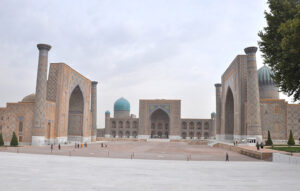SHARE WITH FRIENDS:
Samarkand - Registan ensemble
For centuries, the square where the Registan ensemble was located was the center of Samarkand. The word registan means “sandy place”. Before the first madrasa was built in the square, the river flowed there several centuries ago. Years passed, the river dried up and a large amount of sand was left there, the first madrasah was built in the early 15th century and was called Registan Square. When the madrasa was first built, it hosted all the festivities, parades, ceremonies and Sunday markets. The ensemble consists of three madrasas: Ulugbek Madrassah (17th century), Sher-Dor Madrassah (17th century) and Tilla-Qori Madrassah (covered with gold; 10,12,20th century). Madrasa is a Muslim university. Studying in the madrasa lasted for XNUMX, XNUMX, XNUMX years. The main discipline for all the students was to study the Qur’an. The remaining subjects were optional and could be chosen by students.
Ulugbek Madrasah was built by the order and leadership of Ulugbek. The construction of this madrasah lasted only three years from 1417 to 1420. During the construction of the madrasa, Ulugbek lectured on mathematics and astronomy until his death.
Two hundred years later, the ruler of Samarkand, Yalangtush Bahodir, ordered the construction of a replica of the madrasa, and a second madrasa, the Sher-Dor madrasa, was built next to it. The difference between these two madrassas is that Sher Dor Madrassah has two winter reading rooms, but the main structure was the same as Ulugbek Madrassah.
A few years later, the same Samarkand ruler ordered the construction of a third madrasa, the Tilla-Qori madrasa. Its appearance is the same as the other two madrassas, but when you enter it you will see a one-story building. To create an architectural ensemble, the architecture is built on two floors on the outside, only one on the inside. The madrasa was always built with a single project - a four-cornered courtyard and four awnings and rooms along the entire perimeter. Two other entrances were used for the main entrance, which was always closed by a grid. The doors of the cells were always built low, because “Islam” means “obedience,” so everyone who entered or left the room had to always bow down and greet everyone and wish them good health.
The Tilla-Qori madrasah was originally built as a madrasah, but was mainly used as a mosque; simply looking at the towers, there were low towers in Tilla-Qori to call people to prayer.
In the 17th century, the Tilla-Qori Mosque and Madrasah were the largest mosques in Samarkand. Until the XNUMXth century, madrassas and madrassa-mosques were used purposefully, and only from the beginning of the XNUMXth century to the present day have they served as architectural monuments.
There is also a bathhouse on the west side of the madrasa, in the caravanserai of the Hanaqah and Registan ensembles. Hammomi Mirzoyi was perfectly built not only in Samarkand, but also in the East, and was completely different from other baths (baths). The following information about this building is given in “Boburnoma”: “Mirzo Ulugbek built a moderate bath in this madrasa and Khanakah. It was the famous Mirzai bath. Such a bath exists not only in Khorasan, but also in Samarkand. ” During the reign of Mirzo Ulugbek, the Registan ensemble was the main social center of Samarkand. Meetings were organized here, decrees were issued, and the festivals of Eid al-Fitr and Eid al-Adha were held here.


